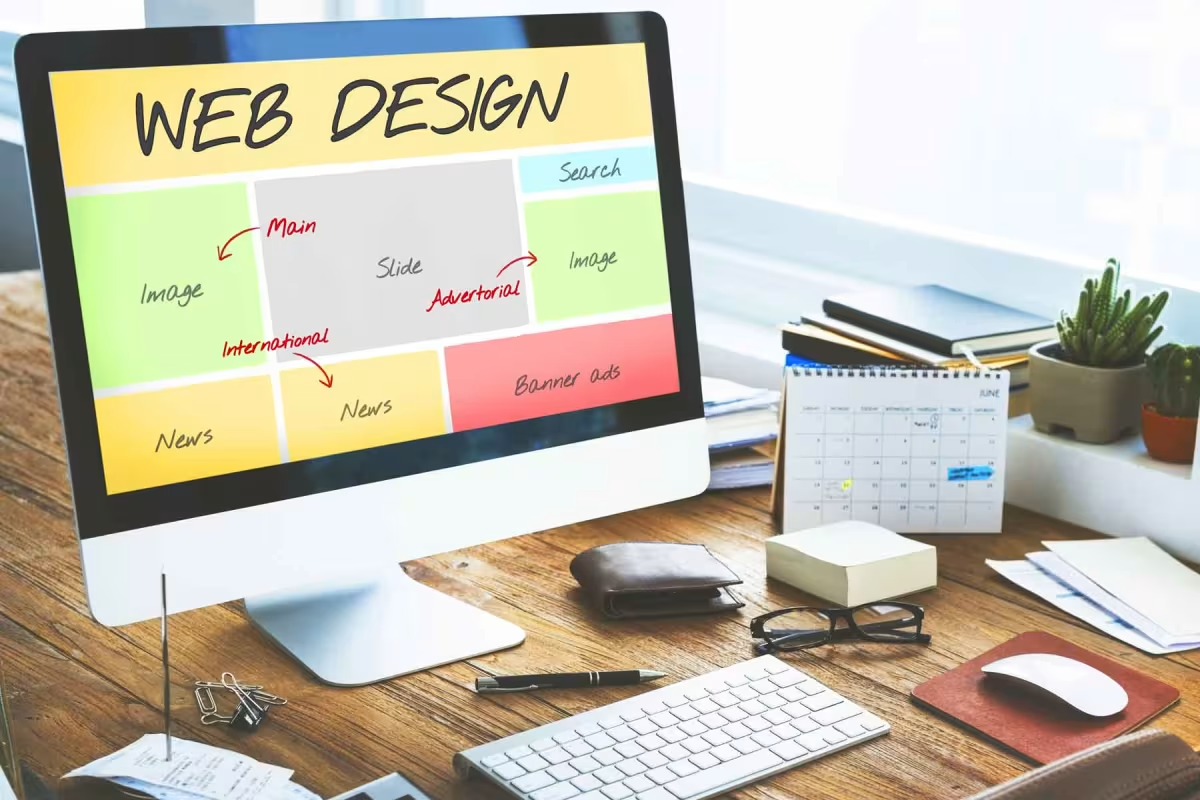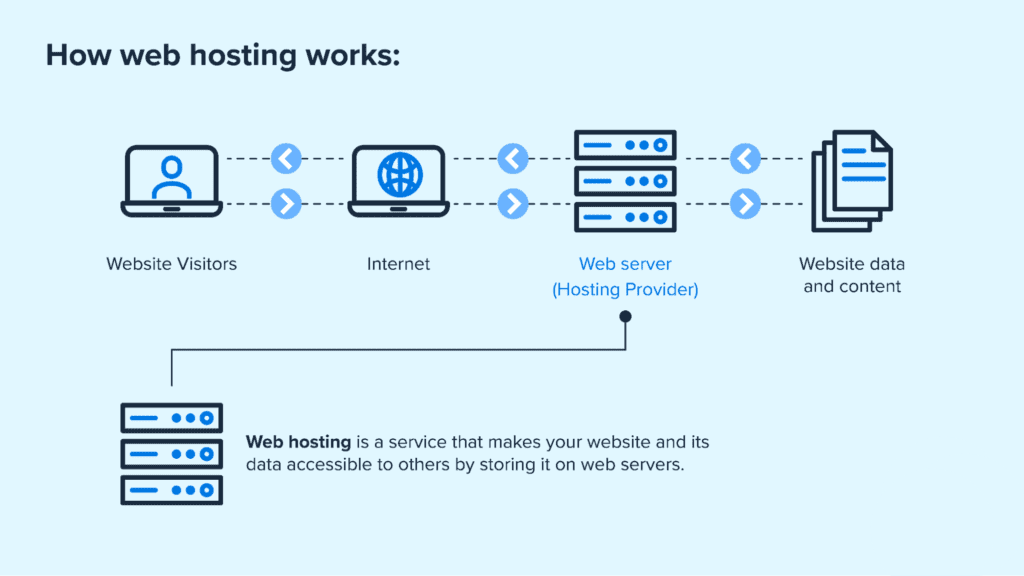When I first started building websites I quickly realized there’s a big difference between website design and web hosting. It’s easy to mix them up but each plays a unique role in getting a site online and making it work smoothly. If you want your online presence to stand out you’ll need to understand what sets these two apart.
Website design focuses on how a site looks and feels while web hosting is all about where your site lives on the internet. Knowing how they work together can save you time money and plenty of headaches down the road. Let’s clear up the confusion so you can make smart choices for your next project.
Understanding Website Design

Understanding-Website-Design
Website design shapes how users interact with a site, influencing both perception and functionality. I separate design from web hosting since design focuses on appearance and usability, not storage or infrastructure.
Key Elements of Website Design
I consider website design as a group of visual and technical components that determine site presentation. These components include:
- Layout Structure: Layout organizes text, images and navigation menus for clear content flow. Grids, for example, maintain alignment.
- Color Scheme: Color influences brand recognition and accessibility. High-contrast palettes help users with visual impairments.
- Typography: Font style, size and spacing affect both readability and mood. Sans-serif fonts increase clarity on screens.
- Imagery and Icons: Images and icons establish brand tone. Stock photos and custom graphics illustrate key messages.
- Responsiveness: Responsive designs adjust site appearance for desktops, tablets and mobile devices. Media queries support adaptive layouts.
| Key Element | Purpose | Example |
|---|---|---|
| Layout Structure | Content alignment, clear navigation | Grid-based layout |
| Color Scheme | Brand consistency, accessibility | Blue/white palette |
| Typography | Text clarity, tone | Sans-serif fonts |
| Imagery/Icons | Visual communication, appeal | Custom illustrations |
| Responsiveness | Device adaptability | Mobile-first view |
Importance of User Experience
- Navigation Ease: Simple menus and logical site hierarchy allow quick movement between pages.
- Loading Speed: Quick-loading pages keep bounce rates low and engagement high. According to Google, pages loading in under 2 seconds perform best in user retention.
- Accessibility: Sites accessible via keyboard navigation and screen readers reach broader audiences. I include alt text for images and clear button labels.
- Consistency: Uniform headers, footers and button styles avoid user confusion.
| UX Factor | Impact on Visitors | Supporting Data |
|---|---|---|
| Navigation Ease | Improves task completion | 68% leave if site navigation fails (Clutch.co) |
| Loading Speed | Reduces user abandonment | 53% leave if page loads over 3s (Google) |
| Accessibility | Expands potential audience | 1 in 4 US adults has a disability (CDC) |
| Consistency | Increases brand trust and revisits | Consistent visuals raise trust by 33% (Lucidpress) |
Exploring Web Hosting
Web hosting offers the technical infrastructure needed for websites to be accessible worldwide. I rely on web hosting to store site files, maintain uptime, and provide resources that support visitor traffic, especially when distinguishing hosting needs from site design requirements.
Types of Web Hosting Services
Web hosting services fall into several categories, each tailored to unique project demands. I reference this table for a concise look at hosting types and their key characteristics:
| Hosting Type | Description | Ideal Use Cases |
|---|---|---|
| Shared Hosting | Multiple websites share a server and its resources | Low-traffic, personal blogs |
| VPS Hosting | Virtualized server with isolated resources | Small business, growing sites |
| Dedicated Hosting | Entire server dedicated to one website | High-traffic, enterprise sites |
| Cloud Hosting | Network of servers, highly scalable and reliable | Rapidly growing traffic, scaling |
| Managed Hosting | Provider manages technical aspects | Beginners, non-technical users |
| WordPress Hosting | Optimized specifically for WordPress CMS | WordPress-centric sites |
| Reseller Hosting | Users resell hosting to clients | Agencies, hosting businesses |
| Co-located Hosting | User-owned server in provider facility | Maximum control, complex needs |
Shared hosting minimizes costs for small sites and personal projects. VPS options offer more isolated resources for growing businesses. Dedicated hosting suits enterprises anticipating high volumes. Cloud hosting scales for fluctuating demand, while managed and WordPress hosting address specific tech skill gaps or platform needs.
Factors to Consider When Choosing Web Hosting
Several factors directly impact which web hosting service I select for web projects:
- Traffic Volume: Large visitor numbers demand VPS, dedicated, or cloud hosting.
- Budget: Shared or free hosting fits tight budgets, though higher-tier plans boost features.
- Technical Skills: Managed and WordPress hosting accommodate those without server management skills; advanced users gain control with VPS or dedicated options.
- Scalability: Cloud hosting handles traffic surges or business growth with ease.
- Special Requirements: Unique CMS preferences or custom server configurations call for specialized hosting.
Here’s a comparison of how common hosting factors align with each service:
| Factor | Shared | VPS | Dedicated | Cloud | Managed | WordPress | Reseller | Co-located |
|---|---|---|---|---|---|---|---|---|
| Cost | Low | Medium | High | Medium | Varies | Medium | Varies | High |
| Scalability | Low | Medium | Medium | High | Medium | Medium | Medium | High |
| Control | Low | Medium | High | Medium | Low | Low | Medium | High |
| Technical Skills | Low | Medium | High | Medium | Low | Low | Medium | High |
| Performance | Basic | Good | Excellent | Excellent | Good | Good | Varies | Excellent |
Careful evaluation of these aspects matches hosting capabilities to site design goals and business needs.
Website Design vs Web Hosting: The Key Differences

Website-Design-vs-Web-Hosting_The-Key-Differences
Website design and web hosting play separate but connected roles in building an online presence. I often see confusion between both, but understanding their differences helps match site requirements with technical resources.
Roles and Responsibilities
Website design covers the structure, appearance, and interface of the site. I use web-based builders, content management systems (CMS) like WordPress, or code-based development to create layouts, graphics, content presentation, and interactive elements. These design tools offer either template-driven speed or custom coding freedom, with builders providing simplicity for portfolios and blogs, and coding enhancing customizability for businesses.
Web hosting takes charge of serving site content to visitors. Host providers allocate server space, manage files, supply bandwidth, handle uptime, secure connections, and support site scalability. Hosting services range from shared plans suitable for new personal sites to dedicated or cloud servers supporting complex or high-traffic business websites.
| Responsibility Area | Website Design | Web Hosting |
|---|---|---|
| Visible Structure | Layouts, colors, fonts, images | Not directly visible |
| Technical Setup | No server involvement, only code files | Server hardware and software |
| Main Focus | User engagement and aesthetics | Site availability and resource management |
Impact on Website Performance
Web hosting directly impacts how quickly visitors access site content and whether the site remains available during heavy traffic or technical incidence. I choose hosting based on uptime guarantees, bandwidth limits, server type, and security features, as each of these controls loading speed and reliability.
Website design influences how users perceive and navigate the site by controlling navigation structure, visual hierarchy, and responsiveness. However, I recognize that even the best design can’t compensate for slow server response or downtime caused by poor hosting.
| Performance Area | Influence of Design | Influence of Hosting |
|---|---|---|
| Loading Speed | Optimized images and code | Fast server response, sufficient bandwidth |
| Uptime | Minimal impact (except for heavy files) | Directly controlled through provider |
| Security | Secure code practices | SSL certificates, firewalls, DDoS protection |
| Scalability | Efficient design aids mobile expansion | Hosting plan upgrades and resources |
How Website Design and Web Hosting Work Together

How-Website-Design-and-Web-Hosting-Work-Together
Alignment between website design and web hosting is critical for building a user-friendly, high-performing website. I pair design strategies and hosting options carefully to match visual, functional, and technical priorities.
Integration for a Seamless Website Experience
Integration between website design and web hosting determines how content, features, and visual elements display for users. I select hosting plans that match the resource needs of design elements, like high-resolution images or interactive components, ensuring loading speed and scalability. For instance, CMS-optimized hosting, such as plans configured for WordPress, boosts site performance for designs built with that platform. Site builders bundle design and hosting for simplicity but limit advanced customization compared to using standalone hosting with flexible CMS or custom code options.
| Design Element | Hosting Requirement | Impact on Experience |
|---|---|---|
| High-res images, videos | Increased storage and bandwidth | Smooth media playback, fast loads |
| Complex interactive UI | Reliable CPU and memory resources | Responsive interfaces, no lag |
| Integrated CMS (e.g. WP) | Platform-optimized hosting | Quick updates, efficient scaling |
| Custom code features | Access to advanced server settings | Full design flexibility, security |
I ensure every feature, from responsive layouts to intuitive navigation, runs efficiently by aligning my design decisions with the technical strengths of the chosen host.
Hosting Choice for Online Casino Websites
Online casino websites depend heavily on both advanced website design features and robust hosting solutions. I focus on scalable and secure hosting to support high user traffic, sensitive transactions, and dynamic gaming content.
| Casino Site Challenge | Design Priority | Hosting Solution |
|---|---|---|
| Real-time gaming | Slick interactive graphics, fast UI | High RAM/CPU, low latency |
| Account management | Secure login, personalized dashboards | SSL, isolated environments |
| Payment processing | Encrypted forms, error handling | PCI DSS compliance |
| Global player access | Localized UX, responsive design | CDN, scalable data centers |
I coordinate premium hosting features with innovative design to deliver fast, secure, and immersive online casino experiences.
Performance and Scalability Alignment
Performance and scalability depend on my ability to anticipate design demands and select hosting that supports them under real-world conditions. High-traffic events, traffic spikes, or content updates won’t disrupt user experience when design and hosting work hand in hand.
| Traffic Volume | Design Load (site files/assets) | Recommended Hosting |
|---|---|---|
| Low | Basic graphics, simple navigation | Shared hosting |
| Moderate | CMS themes, moderate images/videos | VPS or managed WordPress hosting |
| High | Dynamic content, heavy media | Dedicated or cloud hosting |
I plan for both current demands and future scalability, pairing flexible hosting infrastructure with scalable design best practices.
Compatibility and Technical Optimization
Compatibility between website design technologies and hosting environments prevents display issues, errors, or reduced performance. I match server specifications with required languages (like PHP or Node.js), databases (MySQL, MongoDB), and software (WordPress, Drupal) so every design feature operates smoothly.
I evaluate feature requirements against hosting specs, deploying updates or migrations when new design techniques emerge or site traffic grows.
| Tech Stack | Essential Hosting Feature |
|---|---|
| WordPress, Joomla, Drupal | CMS-optimized environment |
| Custom coded sites (JS, PHP) | SFTP/SSH, custom configs |
| E-commerce integrations | PCI compliance, backups |
This structured integration ensures stable, fast, and visually appealing websites regardless of the project’s complexity.
Choosing the Right Solutions for Your Needs
Selecting website design and web hosting solutions depends on project goals, technical skills, growth plans, and budget. Each choice affects user experience, site reliability, and future scalability.
Factors Guiding Your Decision
- Control and Customization: Advanced features and unique branding come from custom-coded design with independent web hosting. Website builders limit design flexibility and third-party integrations but speed up setup for simple projects.
- Ease of Use: Beginners benefit from website builders like Wix or Squarespace, which bundle templates, design tools, and hosting. Custom hosting platforms suit users with coding knowledge or those using CMS options such as WordPress.
- Cost Structure: Website builder pricing stays predictable, usually with monthly or yearly plans from $12 to $40 per site. Web hosting plans vary based on add-ons, storage, and traffic, with basic shared hosting starting near $3 per month and premium managed hosting costing $20–$60 monthly.
- Scalability: Large sites or those requiring advanced security use scalable web hosting, such as VPS or cloud hosting. Website builders support growth but may hit design or resource ceilings over time.
- Technical Demands: Custom hosting options manage high-traffic or resource-heavy sites, with manual server configuration possible. Site builders maintain infrastructure behind the scenes but can’t match deep customization.
| Solution Type | Customization | Ease of Use | Starting Cost (USD/mo) | Scalable | Example Use Case |
|---|---|---|---|---|---|
| Website Builder | Limited | High | $12 | Moderate | Small business brochure site |
| Shared Hosting | Full | Moderate | $3 | Limited | Personal blog or portfolio |
| VPS Hosting | Full | Low | $20 | High | Medium e-commerce & forums |
| Cloud Hosting | Full | Low | $30 | Very High | Rapidly growing SaaS |
| Managed WordPress | High | High | $20 | High | High-traffic WordPress blog |
Online Casino Websites: Matching Design and Hosting for High Performance
Casino sites integrate complex, interactive gaming features and require high security, rapid loading, and uninterrupted uptime. Professional web design focuses on immersive interfaces and responsive layouts while top-tier hosting offers dedicated or cloud solutions for handling spikes in player volume.
| Feature | Web Design Need | Hosting Requirement |
|---|---|---|
| Game Integration | Interactive gaming elements | High memory, CPU |
| Transactions | Secure payment UI | Premium SSL, DDoS protection |
| Traffic Peaks | Real-time response, low latency | Auto-scaling cloud, failover redundancy |
| Compliance | Regional adaptation | Data localization, audit logging |
Choosing the right combination of website design and hosting ensures the site matches user expectations and performs under demanding conditions.
Conclusion
Choosing the right mix of website design and web hosting shapes how your brand is experienced online. I always recommend taking the time to assess your project’s unique needs before making decisions. A thoughtful approach lets you build a site that not only looks great but also performs reliably for your audience.
With the right foundation in place, you’ll be ready to adapt and grow as your goals evolve. Investing in both design and hosting pays off in stronger engagement, better performance, and greater peace of mind.
Frequently Asked Questions
What is the difference between website design and web hosting?
Website design focuses on the look, layout, and user experience of your site, while web hosting provides the server space and resources needed to make your website accessible online. Both are essential but serve different purposes.
Why do I need both website design and web hosting?
Website design creates the visual and interactive elements users see, while web hosting stores these site files and delivers them to visitors. You need both to build and maintain a functional, accessible website.
How does website design impact user experience?
Good website design ensures easy navigation, fast loading times, readability, and consistency. These factors make your website more enjoyable and accessible, encouraging visitors to stay longer and return often.
What are the main types of web hosting?
Common types include shared, VPS, dedicated, cloud, managed, WordPress, reseller, and co-located hosting. Each type offers different levels of performance, control, and scalability to match various website needs and budgets.
How do I choose the right web hosting for my website?
Consider your website’s traffic, growth plans, budget, required features, and technical skills. Choose a hosting type and provider that aligns with your design needs and offers reliable performance and security.
Can I change my web hosting without redesigning my site?
Yes. You can switch web hosting providers without altering your website’s design by migrating your existing site files and databases to the new server.
How do design elements affect hosting needs?
High-resolution images, videos, and interactive features require more server resources and bandwidth. For such designs, choose hosting with enough power and scalability to support smooth loading and performance.
Is a website builder the same as web hosting?
No. A website builder provides tools to design and build your site, often including hosting in their packages. However, traditional hosting can be used with custom-built or CMS-based sites for more flexibility.
Why is scalability important in web hosting?
Scalability allows your website to handle increased traffic and resource demands as your online presence grows. Choosing scalable hosting helps prevent downtime during high-traffic events or marketing campaigns.
What should online casino websites consider when selecting design and hosting?
Online casino sites need high performance, advanced security, and the ability to handle large traffic volumes. Choose robust, secure hosting and professional design to ensure reliability, user trust, and legal compliance.

